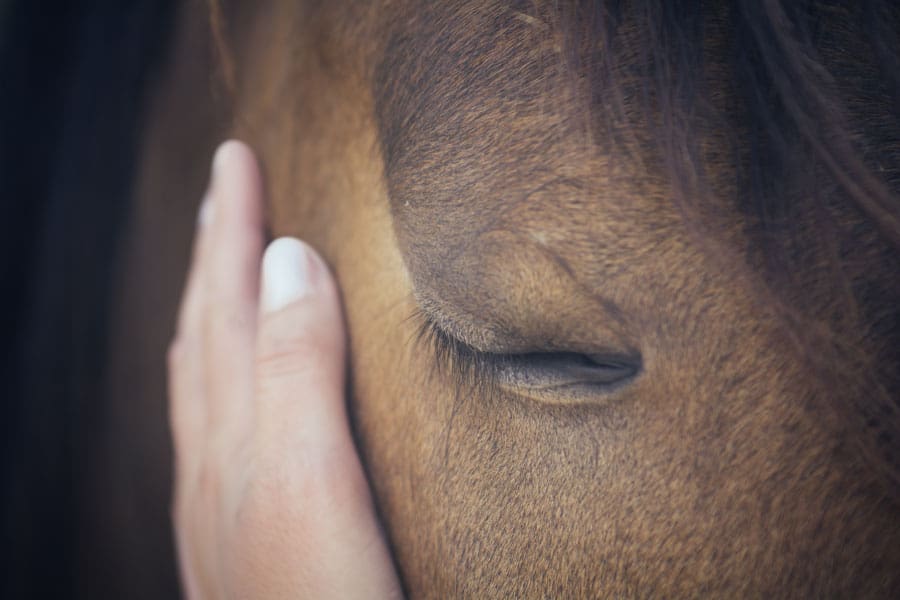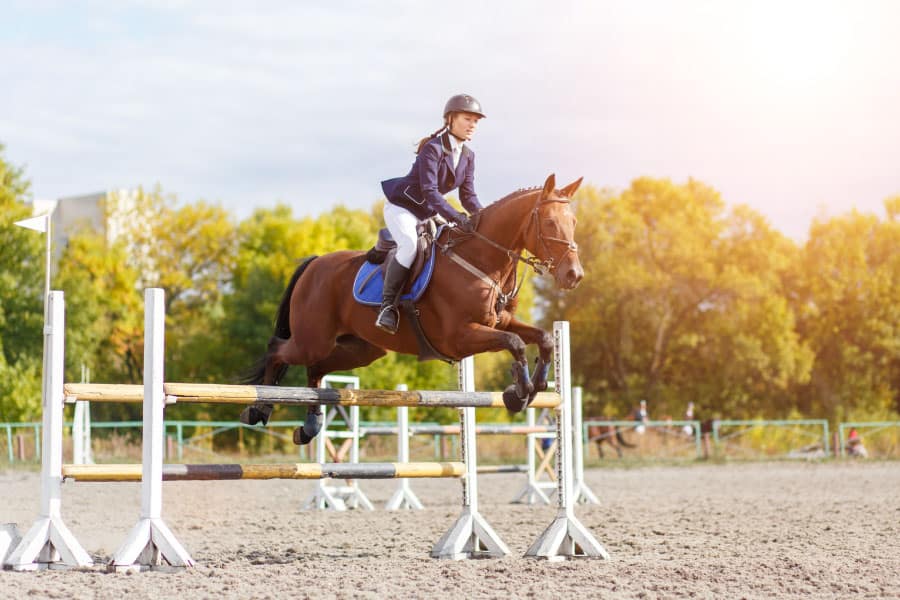- Your source for stall mats, rubber arena footing, arena harrows and arena dust control.

When I was younger and just starting with horses, I always used to wonder whether one-eyed horses could jump and compete in show jumping competitions. After a couple of decades of working with horses, I know a lot more now and thought I’d write this article for those of you who might be wondering the same thing. So can one-eyed horses jump too?
Yes, one-eyed horses can jump and successfully compete in show jumping. Due to their big range of vision (215° per eye), horses can cope incredibly well with just one functioning eye.
Now, if only it was that simple. Because show jumping requires depth perception, jumping a horse with only one eye will have its challenges, and there is also the question of safety. So let’s explore this in more detail.
How do horses see jumps?
A horse has a visual range of 215° per eye. This, along with the placement of their eyes on the side of their heads, means that they can have up to a 350° range of vision. However, horses do have blind spots that are directly in front of their nose and the other extends directly behind their head to their rump.
Colour
Horses see colors differently to humans because they have dichromatic vision. This means that they can only distinguish between two colors – Blue and Green. Studies have shown that horses recognize poles in show jumping that are colorful and patterned more easily
Far or near-sighted
Horses can also be far or nearsighted. Nearsighted horses will have trouble distinguishing jumps from a distance, whereas far-sighted horses will struggle to see the jumps clearly as they approach the jump.
Horses also struggle to focus on details on static, non-moving objects and jumps may appear more fuzzy and flat to horses.
Blind spot
When approaching a jump, from the average take-off point, the jump enters the blind spot of the horse. This means that the horse takes off from memory and blindly rather than being able to see the jump that it is jumping. The horse also uses the ques from their rider in order to know when to jump.
Horses have the largest eyes of all land mammals on earth. This and the large retina causes up-close objects to seem 50% larger than what humans perceive them to be. This means that a simple, small jump becomes a huge blurry object as the horse nears it, which then suddenly disappears as they get closer.
Why do horses lose their eyes/vision?
Birth
Although not common, horses can be born with ocular abnormalities which could cause them to be blind in either one or both eyes.
Injury
Trauma to the surface of the eye is not uncommon in the equine world. The diagnosis and treatment of minor trauma to the eye is fairly easy and quick. A red, swollen, and watery eye is an indication of injury to the cornea (the outer layer).
However, when left untreated, it can cause serious secondary infections that can cause ulcers and devastating deteriorating effects. Should the infection penetrate deeper than just the cornea, it can lead to the loss of the eye.
Illnesses
- Equine Recurrent Uveitis. The most common ocular disease that causes vision loss in horses is Equine Recurrent Uveitis. This is defined as inflammation to the uvea in the eye and is detrimental to the other sensitive structures in the eye as the pressure build-up is damaging. Telltale signs of uveitis are red, inflamed, and painful eyes with a cloudy appearance. This is also known as “Mooneye.” Even though treatment is quite aggressive, half of the affected horses will suffer permanent vision loss. The uveitis can lead to detached retinas, scarring on the eye, severe damage to the internal structures of the eye, or mature cataracts.
- Cataracts and retinal atrophy. Cataracts and retinal atrophy are also observed in horses. Cataracts are spots of cloudiness in the lens of the eye. Mature or fully developed cataracts can lead to blindness.
- West Nile disease. West Nile virus has been recorded to cause acute blindness in some horses.
Adaptation period after losing sight in one eye
The time it takes a horse to adapt to losing vision in their eye depends on the horse, and the reason for the vision loss. If your horse lost its vision progressively over a period of time, it would adapt more quickly.
If your horse becomes blind, suddenly, they tend to take longer to adapt. A spooky and nervous horse will need a long adaptation period as well as “desensitizing” help to get comfortable with only one functioning eye.

How to train a one-eyed horse
- Introduce color. Helping your horse see and recognize the poles for jumps is a big must to build their confidence over jumps, thus using colored and patterned poles is essential.
- Sound sensitive. Start with your horse on the ground. Simply getting him/her accustomed to you, working on their blind side, is extremely important. This is the first way to build trust with your horse. After that, work in hand and walk them through different exercises and in different areas. Your horse will be much more sound-sensitive on the blindside. Thus it is crucial to take things slow and get them used to different kinds of sounds.
- Pole work. When your horse is comfortable to do in hand and lunge work, you can slowly take them over poles. It is vital to allow the horse to move their heads freely to look at the poles and become comfortable over the poles. Once the horse is comfortable and confident, one can allow less movement with their head until they can comfortably go over poles with the ‘normal’ head position.
- Getting on from the blindside. Your horse would need to get accustomed to you, mounting them from their blind side, if they lost their vision on their left side.
Is it safe to jump a one-eyed horse?
Jumping with a one-eyed horse depends on the horse. A horse will adjust exceptionally well. The rider needs to be competent, confident, and teamwork is essential. The horse will be spookier and more sensitive to sounds on their affected side, but with the right training, adjusting, and lots of patience, the horse can perform just as well as a horse with normal vision.
One-eyed horses get accustomed to their new circumstances and develop other senses to help them on the blind side. Their depth perception also adjusts well.
Can a one-eyed horse compete successfully?
Here are a few examples of one-eyed horses achieving great success in competitions:
- Marcus Ehning competed on Cornado NRW, and he had lost his eye in 2018. The stallion competed in the high levels of show jumping, but a devastating injury resulted in him having his eye removed. After surgery, he adjusted quickly and since then returned to the jumping ring, competing at 1.45m.
- Izzy Taylor competed with Briarlands Blackberry in eventing. She started riding him two years after losing his eye. She observed that it didn’t affect him or his performance at all.
- Malin Baryard-Johnsson’s horse Tornesh had problems with his vision for 8years, only having 30% vision and losing an eye after an injury. The stallion continued to compete in CSI5* show jumping competition until his retirement in 2016.
- Trevor Been competed with his horse a year after his horse lost his eye, and Adventure De Kannan was the 2014 winner of the Hickstead Derby.
All these top riders and one-eyed wonder horses are proof that a horse can compete and perform like top athletes with only one eye.
It all comes down to trust, personality, heart and horsemanship.
How to detect if your horse might have a vision defect?
One of the hardest things to do is to be able to detect if your horse has a problem with their vision. Some behavioral problems can arise from visual troubles but are rarely thought of by the owner. Unless, of course, the horse has had their eye removed.
Horses can show head shaking, spookiness, shying, startled responses, and other behavioral signs that there may be the result of an acute visual defect.
Horses that have been dealing with visual defects or total loss of vision can appear quite normal as they still have a big range of vision, and they also rely on their sense of touch, through their whiskers and lashes to detect surfaces near them.
The way a horse handles the loss of an eye depends entirely on the horse and their personality.
How to test your horse’s vision
There are a couple of eye ways to check the vision of your horse:
- Using a cotton ball. Cover the one eye with your hand or a blinder, use cotton balls and throw it upwards into the air in front of the other eye. You should be able to see the horse following the cotton ball or not.
- Using a pole. You can place a garden hose/pole on the ground and lead your horse over it with one eye covered.
- Rapid hand movement. Cover one eye and wave or move your hand in front of the other eye, the horse should react by flinching or blinking. Be careful not to take your hand to close as you can create small air currents in which the horse will pick it up and react.
Conclusion
Horses, being prey animals as well as athletes, rely mainly on their vision. Thus, the loss of vision in one or both eyes is devastating. However, this does not mean that the horse cannot lead a healthy and even a competitive life.
Once again, it all comes down to trust, personality, heart and horsemanship.

